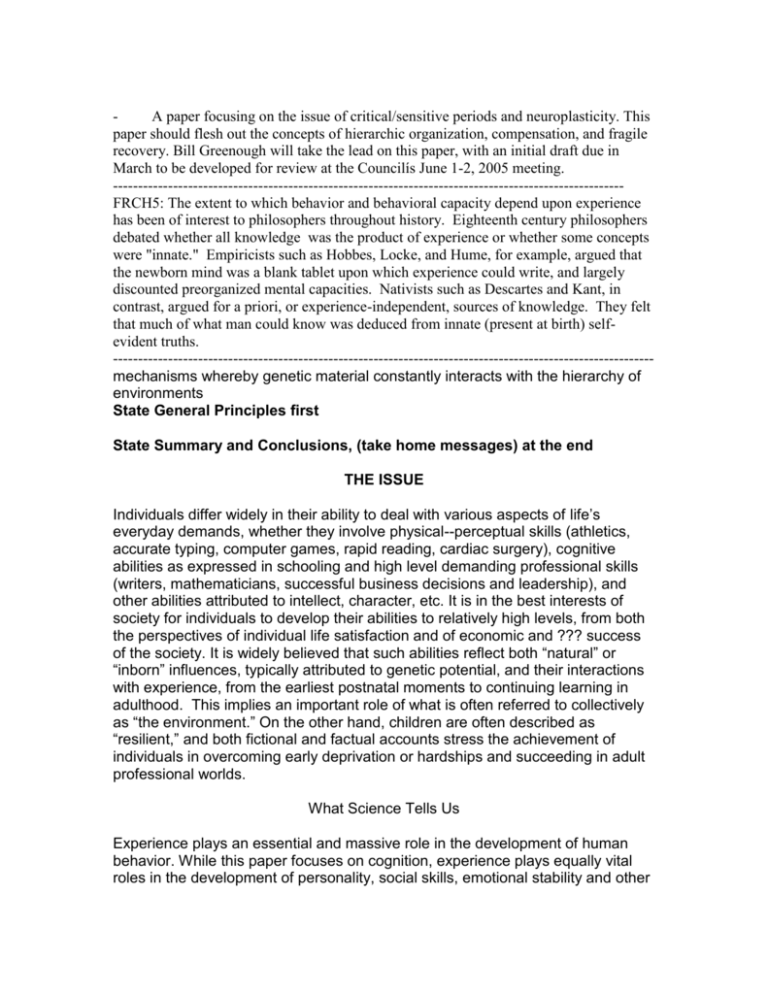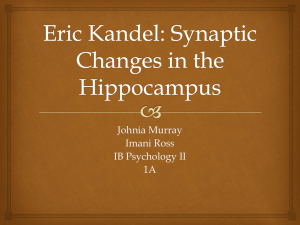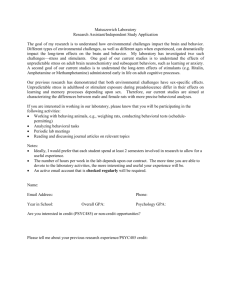Experience & Development Take 2
advertisement

A paper focusing on the issue of critical/sensitive periods and neuroplasticity. This
paper should flesh out the concepts of hierarchic organization, compensation, and fragile
recovery. Bill Greenough will take the lead on this paper, with an initial draft due in
March to be developed for review at the Councilís June 1-2, 2005 meeting.
-----------------------------------------------------------------------------------------------------FRCH5: The extent to which behavior and behavioral capacity depend upon experience
has been of interest to philosophers throughout history. Eighteenth century philosophers
debated whether all knowledge was the product of experience or whether some concepts
were "innate." Empiricists such as Hobbes, Locke, and Hume, for example, argued that
the newborn mind was a blank tablet upon which experience could write, and largely
discounted preorganized mental capacities. Nativists such as Descartes and Kant, in
contrast, argued for a priori, or experience-independent, sources of knowledge. They felt
that much of what man could know was deduced from innate (present at birth) selfevident truths.
-----------------------------------------------------------------------------------------------------------mechanisms whereby genetic material constantly interacts with the hierarchy of
environments
State General Principles first
State Summary and Conclusions, (take home messages) at the end
THE ISSUE
Individuals differ widely in their ability to deal with various aspects of life’s
everyday demands, whether they involve physical--perceptual skills (athletics,
accurate typing, computer games, rapid reading, cardiac surgery), cognitive
abilities as expressed in schooling and high level demanding professional skills
(writers, mathematicians, successful business decisions and leadership), and
other abilities attributed to intellect, character, etc. It is in the best interests of
society for individuals to develop their abilities to relatively high levels, from both
the perspectives of individual life satisfaction and of economic and ??? success
of the society. It is widely believed that such abilities reflect both “natural” or
“inborn” influences, typically attributed to genetic potential, and their interactions
with experience, from the earliest postnatal moments to continuing learning in
adulthood. This implies an important role of what is often referred to collectively
as “the environment.” On the other hand, children are often described as
“resilient,” and both fictional and factual accounts stress the achievement of
individuals in overcoming early deprivation or hardships and succeeding in adult
professional worlds.
What Science Tells Us
Experience plays an essential and massive role in the development of human
behavior. While this paper focuses on cognition, experience plays equally vital
roles in the development of personality, social skills, emotional stability and other
facets of what we often view as the most human characteristics of people.
Cognitive development often involves specific windows in time when essential
events occur, indicating that some things are best acquired at particular stages of
development. For example, in order to learn to understand and produce speech,
the infant must first learn how to break up a nearly continuous auditor
--------------------------------------------------------------------------------------------------------Knowledge of the manner in which intrinsic predispositions and experience come
together in development comes from studies of both animals and humans. The
fundamental systems interacting in development—genes and their pattern of
expression, the neurons and other cells of the brain, behavioral interactions with
the world—differ both across animal species and from animals to humans, of
course, but are in the majority of cases remarkably similar and behave in similar
ways.
At the next level—that of the neuron and its connections with others—the
question is how do these experience-gene-protein interactions affect neurons
(and other brain cells) in ways that alter behavioral abilities or tendencies? How
does experience contribute to the functional organization of the brain? This is an
area in which neuroscientists have begun to generate some very interesting
answers.
It has long been known that developing animals acquire information from some of
their very earliest experiences that play major roles in shaping later behavior.
The ethologist Konrad Lorenz showed many decades ago that waterfowl such as
young geese and ducklings learned to recognize their mother through brief
experiences with her shortly after hatching. If the normal mother was not present,
the birds often latched onto whatever animate object was present, such as
Konrad Lorenz himself. Lorenz noted that the young goslings followed him as if
he were their mother and that, later in life, the birds would often approach him,
rather than another goose, with various aspects of their mating behavior. Lorenz
and other researchers described a “critical period,” shortly after hatching, during
which the birds became “imprinted” upon the characteristics of the parent, first as
a maternal figure and subsequently as the characteristics to be sought in a
mating partner. Subsequently, other developmental events were discovered that
had similar characteristics: normal development required particular experiences
at particular times. Some scientists suggested the term “sensitive period” for at
least some of these events, as there appeared to be varying degrees of
sensitivity to the experience across a period of development.
The aspects of development that exhibited a sensitive period for particular
experiences went well beyond maternal recognition. Very common among
animals such as cats and monkeys was the importance of normal patterned
visual experience to the development of normal visual ability. If one eye was
covered for as little as a week after a kitten’s eyes opened, that eye became
essentially blind. Depriving both eyes simultaneously impaired vision in both
eyes, although less severely than when only one eye was deprived. If a period of
normal vision intervened after eye opening, later deprivation had little or no effect
(although there are circumstances where it may). Similar effects were seen in
humans that developed with abnormal visual experience due to aberrations in the
optics or the orientation of the eyes. Thus the development of normal vision
required normal early visual experience, with a decreasing effect of deprivation
following an increasing period of normal experience. Parallels to this
phenomenon were described in other sensory modalities of various species.
What is common to these developmental processes is the involvement of an
experience, such as the presence of the animated and responsive maternal
goose or of normal patterned visual experience, that would occur with very high
reliability to any member of the species developing in a normal environment.
These experiences appear to occur so reliably that they could be anticipated in
the genetically-driven program for development and counted on to occur.
Moreover, these processes may have advantages, relative to accomplishing
brain organization without the influence of experience. In the case of the goose,
recognition of one’s individual mother might ensure parental attention, while in
the visual system a higher quality of function, adapted to the individual’s
characteristics (e.g., distance between the eyes), can be generated. A term that
has been used to describe these processes is “experience-expectant”
development, highlighting the expectation in the developing nervous system that
these experiences (seeing the mother or seeing patterned visual stimuli) will
occur.
In at least some cases, a special developmental process appears to be involved
in experience-expectant development: synapses are produced—often before the
event occurs—that have the ability to encode the effects of the experiences in
the brain. Thus in the developing kitten visual system, Hubel and Weisel ()
demonstrated that synapses between the pathways carrying visual information
from the eyes and the neurons of the visual cortex were produced in an
overlapping manner, such that the potential for several different potential patterns
of connections between eyes and brain were present. With normal binocular
visual experience, appropriate synapses were “stamped in” by the experience
while inappropriate synapses were removed. Thus the patterned stabilization of
appropriate synapses and the pruning of extra, inappropriate synapses
generated the mature, functional pattern of connections that could properly
process visual information. The relationships between the structural synaptic
changes, corresponding changes in neuronal activity and changes in behavioral
performance have been exhaustively demonstrated.
The process of synapse loss, sometimes occurring in parallel with
formation of new synapses, has been described in many brain regions of
both animals and humans. In humans, Huttenlocher has reported that
synapse loss in prefrontal, higher cognitive brain regions may continue
until adolescence.
The declining sensitivity to the expected experience with age appears to
reflect the tendency for stabilization and pruning to go ahead on the basis
of whatever neural activity occurs in the system, regardless of whether it
reflects the expected experience.
The brain also appears to use the formation of synapses (possibly independently
of synapse loss) to incorporate new information from experience. This has been
shown in studies of animals housed in complex, or “enriched,” environments. In
the first such experiment, Hebb (1949) reared laboratory rats as pets in his
home, then took them back to the laboratory to assess their learning ability
compared to rats reared in standard laboratory cages over the same period. The
home-reared rats excelled relative to their lab-reared counterparts. Studies of the
brains of rats reared in the laboratory equivalent of Hebb’s home--large cages
filled with toys and other objects promoting exploration, play and learning—have
found that various regions of the cerebral cortex and of other brain areas respond
both with changes in the structure of synapses and with increases in the number
of synapses, compared to rats reared alone or with another rat in standard
laboratory cages. The structural changes include increased size and changes in
the structure of the parts of the synapse most involved in its communication
processes, details of which are not important here. Increases in the number of
synapses indicate that synaptogenesis, the formation of new synapses, must
have occurred. A substantial number of studies have also confirmed Hebb’s
original behavioral finding that the animals reared in more complex environments
are superior to cage-reared animals in various learning and problem-solving
tasks.
Changes induced by experience in a complex environment are not limited
to neurons and their synapses. Myelin, the glial insulator of axons that
enhances the rate of conduction of nerve impulses, is increased in some
brain pathways of animals reared in complex environments. In addition,
astrocytes, the cells that ensheathe synapses and subserve various
metabolic needs, increase the degree of ensheathement in animals
housed in complex environments. Finally, the brain’s capillary system is
expanded in at least some brain regions in animals housed in a complex
environment, indicating better supply of the nutrient and oxygen needs of
the brain.
Age-dependence In contrast to findings for age dependent, critical or
sensitive period effects of experience in sensory system development, the
effects of exposure to a complex environment on both brain and behavior
can occur throughout postweaning development and even into adulthood.
Thus there is no specific period during which exposure to a rich
environment must occur if it is to affect the brain. On the other hand,
effects are larger and occur more rapidly at earlier ages.
Learning relatively complicated behavioral tasks brings about smaller
changes in the structure and number of synapses. These changes tend to
be localized in brain areas involved in performing the learned behaviors.
These effects can also occur in both young and mature animals, and do
not appear to differ greatly with the age at which the learning takes place.
Is there evidence that the same sorts of brain and behavioral changes take place
in humans when they are exposed to similar environmental challenges?
Obviously it would not be possible to subject children to arbitrary environments
and tasks. Nonetheless, a limited amount of data indicates that human
behavioral development is similarly sensitive to the quality of experience
encountered. Two studies of reasonably high quality have focused upon
enriching the school environment. In the Perry Preschool Project…. In the
Carolina Abecedarian study…. Immediate data…. Long-term follow up data.
[Greg and others could provide the most germane examples of this set of
studies.]
A painfully clear-cut demonstration of the effects of deprived rearing
environments comes from studies of Romanian children who were kept in
minimally stimulating institutional environments with little in the way of human
caretaker intervention beyond minimal sanitary and health care, often from
shortly after birth until ages ranging from to . [chuck and others in the group are
probably more familiar with these studies than I am.] Brain imaging data.
Behavioral data.
Other supportive data from human children
Concluding paragraph: Taken together, these animal and human data show
clearly that the quality of experience determines the quality of development from
the first postnatal sensory experiences to the cognitive challenges of
adolescence and beyond.
Unfounded assertions in the name of science
[Birth to three and Critical periods] Science does not support the sometimes
proposed view that, within the first 3 years of life, a child passes through all of its
major critical periods for development, such that, after this age, intervention will
be largely irrelevant. Clearly there are some aspects of early development, such
as acquiring binocular depth perception and fine visual acuity that can be
disrupted, usually by correctable physical deficits in the orientation or optics of
the eyes. Clearly higher order cognitive processes benefit from early activation
and regular use {do we know anything about over-stimulation that is
documentable?}. But all evidence from animal and human studies appears to
suggest that, beyond the early stages of sensory development, late is far better
than never.
The child is not a blank slate that absorbs all of its knowledge from experience.
In fact, some degree of organization must be present in order for the brain to take
advantage of the contrasts and regularities in experience, from the early shaping
of sensory experience to the social development fostered by recognition of and
response to facial features to the expectations of regularity of actions in the
physical world. Many features of early cognitive and perceptual development
appear to be remarkably well organized at birth or at the first time that they can
be examined. Kuhl and others on speech sound discrimination. Meltzoff on
newborn recognition of facial expression. Early concepts of conservation of
number. Baillargeon on impossible events, infants’ perception of the substance of
objects, conservation of momentum, etc.
The Science-Policy Gap
Quality of home rearing; quality of preschooling programs; quality of K-12
education; importance of a stable, nurturing home environment; [a lot of the
statements in this section of the stress working paper are also valid here] [the
axes of stress; social development and cognitive development are inextricably
tied, and we may want to think about how to sort these out and combine them in
our policy documents.]
Implications for Policy and Programs
I should have contacted Chuck and others earlier about this section. It is not
something that I can write alone.
A common characteristic of most of the examples of sensitive period or critical
period developmental phenomena that have been studied
Recently it has been found that bo
-acuity (pattern vision) and binocular depth perception
-Evidence that newborn children may be sensitive to patterns resembling the human face
and even able to recognize facial expressions at birth (Andy Meltzoff)
-Language phonemic boundaries; many come without experience – here the role is to
select those boundaries that are used in the language(s) that the child acquires
-animal studies in general indicate that the visual system is working in the newborn or at
eye opening but that its acuity, or ability to see fine patterns, increases with age and
visual experience; if the animal is deprived of experience, for example by keeping it in
the dark, visual ability may deteriorate.
-----------------------------------------------------------------------------------------------------------1. Experience plays a very important role in the brain development process, which in turn
is reflected in behavioral performance. This holds true both for fundamental perceptual
and motor skills and for higher-order aspects of behavior such as cognitive and social
abilities.
While it may not be obvious from observing very young children, studies of the
developing visual systems of children and animals have shown that proper development
requires appropriate experience. Developing sensory systems appear to have been
designed during evolution to take advantage of information available in the normal
environment to optimize their performance. In general, the period during which sensory
system function is normally enhanced by experience, and when function can be most
severely impaired by inappropriate experience, occurs in early postnatal development, or,
in animals born with their eyes still closed, such as kittens, shortly after the eyes open.
The development of binocular depth perception, which is based on the positions of
images on the retina of the two eyes, and of the ability to see form (such as objects, facial
expressions and ???), among other visual abilities, have been shown to depend upon
experience beginning at birth, or when the eyes open for kittens and other animals born
with the eyes closed.







